Varieties of large-fruited tomatoes for greenhouses
Content
Overview of varieties
Every year, with the onset of spring, we have to solve an important question - what varieties of tomatoes should be planted in a greenhouse? Rarely does anyone choose only one of the varieties of tomatoes, because their large-fruited varieties are so good that they are suitable not only for eating fresh, but also for preparing canning for the winter.
Experienced gardeners prefer to grow large varieties of tomatoes in greenhouses, because they are very juicy and tasty. There are excellent varieties of tomatoes that are adapted to the conditions of our climate, have a strong immunity to diseases, and are distinguished by a very interesting shape and color.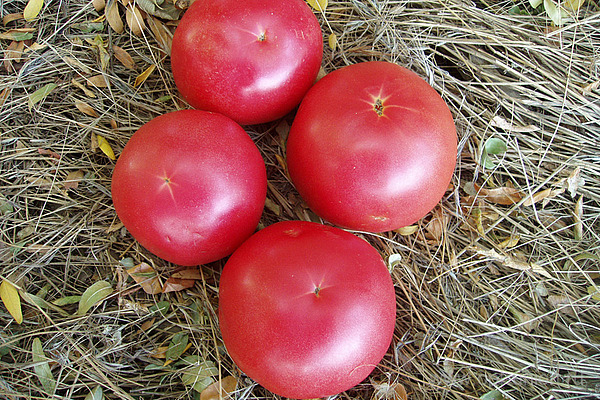
Indeterminate varieties
Such varieties of large-fruited tomatoes are quite tall, have a liana-like structure of bushes and give very large fruits. They almost completely use the entire volume of the greenhouses, which allows them to harvest a good harvest.
In season, from one square meter, you can get about 15 kg of tomatoes. If you opt for hybrid varieties, then the yield can reach 25 kg per square meter of greenhouse.
Mazarin. In industrial greenhouses, tomatoes of this variety can be about 1.8 meters high. Their fruits are distinguished by a beautiful crimson color, and also have an interesting heart shape, and their weight can reach an average of about 600 grams. Best of all, they are able to come in handy for preparing a variety of salads.
Scorpio is large-fruited. This kind of tomato is recommended to be grown in greenhouses. The fruit has a characteristic pink or deep crimson color, and can change hue depending on the light. The average weight of this type of tomato is about 800 grams. If you collect them from a bush green, they can quickly ripen and do not crack. Cardinal. Tomatoes of this variety can grow up to two meters in height. Their fruits are raspberry-colored, fleshy and very sweet. They can weigh approximately 900 grams each. They are well suited for both fresh cooking and preservation.
Bear Paw. A mid-early variety of tomatoes for greenhouses. It has a beautiful red color and rounded, slightly flat, fruits. Each can weigh about 800 grams. Such crops need a garter and timely pinching. And they are advised to plant no more than three pieces per square meter.
Grandma's secret. It has a fairly average growth for indeterminate varieties of tomato - about one and a half meters. But at the same time, it can be safely attributed to the type of super large-fruited. The fruits of such a culture are capable of weighing about a kilogram, and sometimes even more. The main advantage of this type of tomato for greenhouses is the ability to grow them in Siberia. The fruit contains quite a few seeds and a large amount of pulp, which is fleshy and pleases with an excellent taste. Used for the manufacture of preservation for the winter.
Goose egg. A fairly new type of tomato, has rich red fruits, in the shape of an oval, medium-large size - the mass of each vegetable reaches about 300 grams. It has the ability to ripen in a short time after being removed from the bush.
De Barao is a giant.One of the most popular types of tomato for greenhouses. The ripening period for this culture is medium late. The fruits have an unusual cube shape, weigh about 300 grams, are juicy and have excellent taste. They are very loved by gardeners who use them to prepare salads and marinades.
King of the giants. A variety of Siberian tomatoes. It can reach about 1.8 meters in height, and the average is 1.2 meters. Allows you to collect about 8 kg of vegetables from one bush. It has proven itself well during storage and transportation.
Raspberry giant. A type of greenhouse tomato with a fairly early ripening period. It has characteristic fruits of raspberry-pink color, ribbed flat-round shape, which rarely weigh less than 200 grams. These tomatoes are very fleshy, sweet, well suited for preservation for the winter.
Bull heart. It has fruits weighing from 150 to 500 grams. Their shape is quite varied, and the sweet taste tends to persist even after processing.
Hybrids
Hybrid varieties require less maintenance than conventional tall, large-fruited tomato varieties. They can give a high yield even under the condition of sharp temperature jumps and insufficient illumination. They have early and medium-early ripening periods, good immunity to diseases.
Ural F1. Suitable for growing in film and glass greenhouses. It has round beautiful fruits weighing about 400 grams. Up to 8 kg of vegetables can be harvested from one bush, which are used mainly for preparing salads. Very much in need of timely tying and pinching.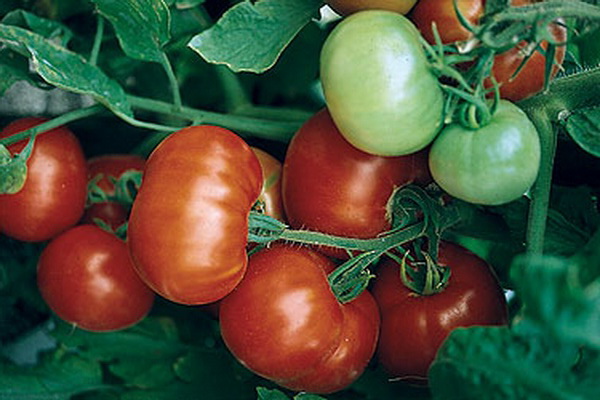
Krasnobay F1. A mid-late variety with flat-round fruits, the weight of which can reach 500 grams, and the yield per square meter is about 40 kg. Well suited both for fresh consumption and for preservation.
F1 handbag. An early ripening tomato species that grows only in a greenhouse. It has fruits weighing up to 400 grams, sweet, juicy, which are best consumed fresh.
Cavalcade F1. Tomatoes of an early ripening period, which are grown in shelters in the northern regions and the middle lane, and in the south - in the open field. Quite unpretentious, they have large and tasty fruits.
Gilgal F1. It has an early ripening period and large fruits weighing up to 350 grams. The yield per square meter is approximately 35 kg. The fruits are well kept.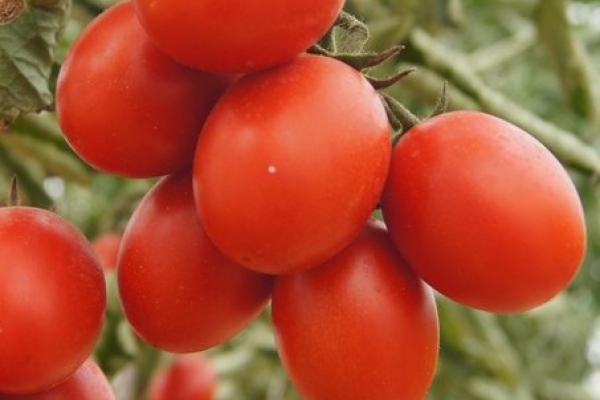
Volgograd F1. It is very similar in quality to the previous type. Only has an average ripening period. Can be stored for a long time, well transported.
Russian size F1 and Sibiryak F1. Tomato varieties are super giants. The average weight of fruits is 500 grams, in the largest ones they can reach 2, 8 kg. It has a wonderful aroma and excellent taste.
The specifics of planting and care
When growing any variety of large-fruited tomatoes, it should be borne in mind that they have the property of growing to the sides and up. Therefore, they should not be allowed to grow arbitrarily, so as not to receive small fruits. It is customary to plant tomato seedlings in a greenhouse in the first decade of May. During this period, the air temperature is still not very high, therefore it is recommended to tighten the greenhouse with a second layer of film, which can be removed at the beginning of June. Airing is important, because in the stuffy and high humidity of the air, the seedlings can die. Seedling beds are made along the greenhouse, the number depends on its width.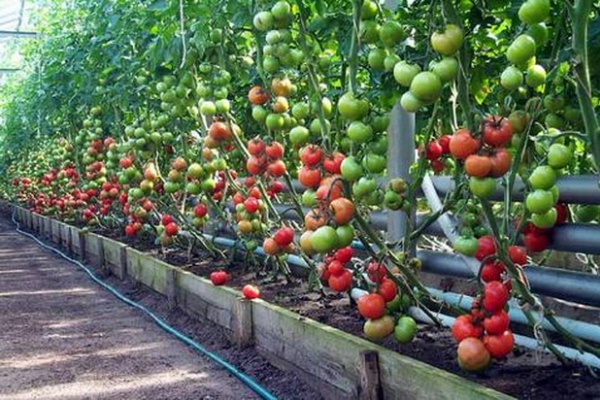 In this case, the width of the bed itself should be about 80 cm. The soil for planting is prepared in three days, you can spill it with hot water with potassium permanganate at the rate of 1 gram per liter. Large-fruited varieties are planted at a distance of about 60 cm.
In this case, the width of the bed itself should be about 80 cm. The soil for planting is prepared in three days, you can spill it with hot water with potassium permanganate at the rate of 1 gram per liter. Large-fruited varieties are planted at a distance of about 60 cm.
Immediately after planting, the seedlings need to be pinned, while leaving no more than two stems. At the same time, side shoots are removed, and in place of the cut stepson, it is imperative to leave a stump of 2 cm so that it does not appear again. On each of the stems, it is necessary to leave about 3 - 6 flower brushes.To limit the growth of crops, when the plant reaches its maximum height, its tops must be pinched, leaving about three sheets above the brush.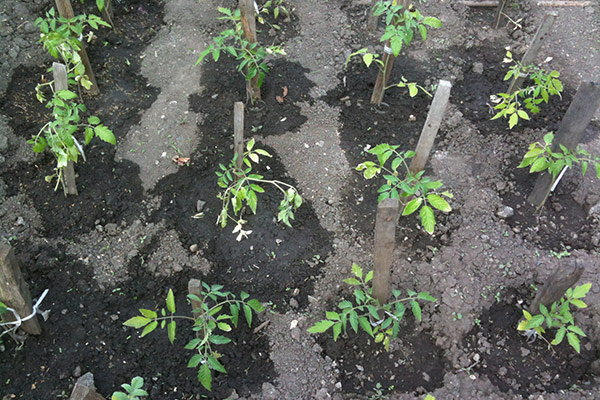
The bushes are advised to be tied to special supports so that they do not break due to the weight of the vegetables that have appeared. It is best to make vertical trellises, pull the wire directly over them so that later you can wind tall crops on them as they grow. In this case, the brushes together with the fruits must be tied separately. Other types of care for large tomatoes are the same as for low and medium-sized varieties.
Video "Tomato varieties"
In the video, the man talks about those varieties of tomatoes that are suitable for growing in greenhouses.
